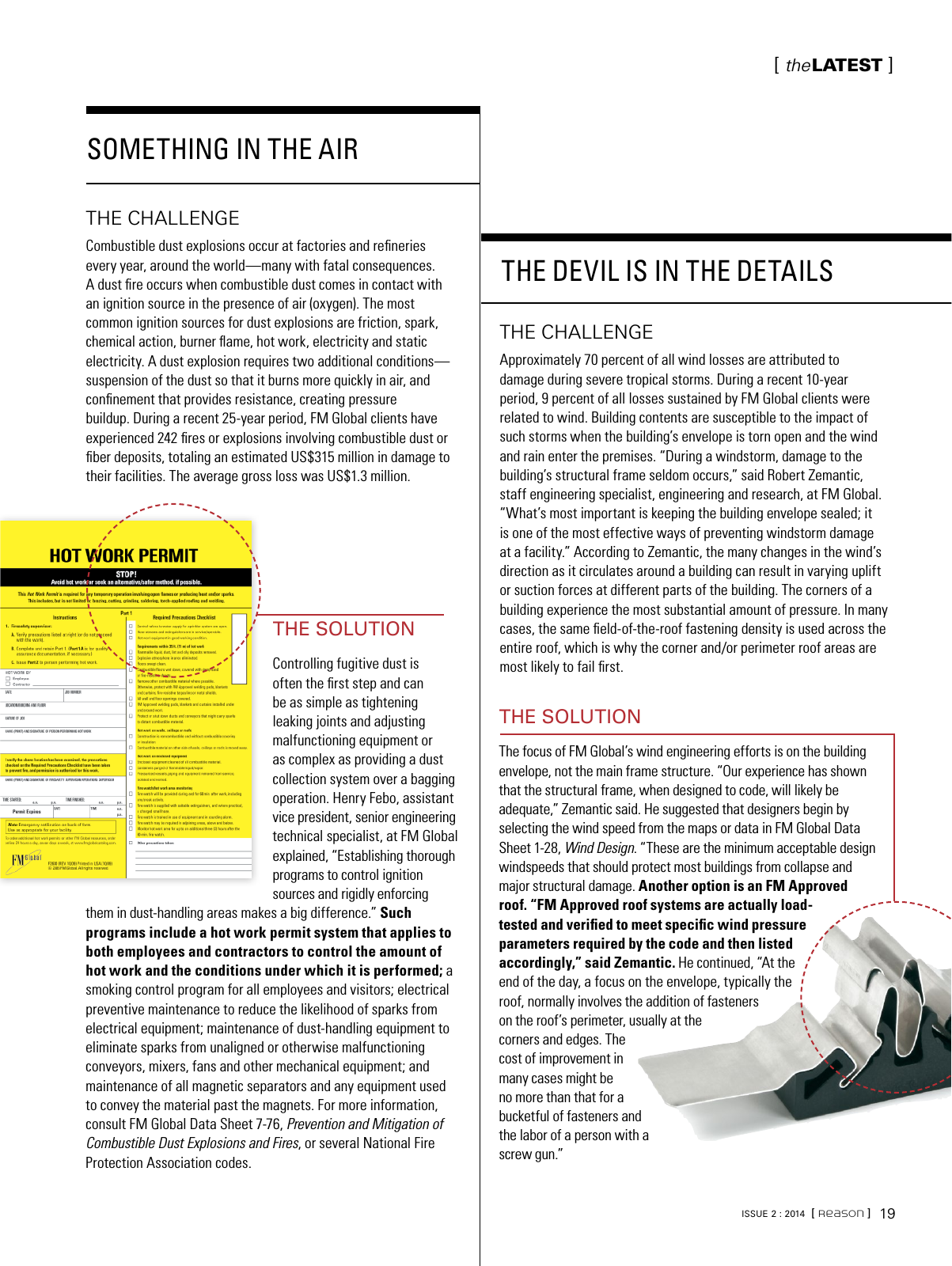Reason Magazine 2014 Quartal 2 Seite 19
Hinweis: Dies ist eine maschinenlesbare No-Flash Ansicht.Klicken Sie hier um zur Online-Version zu gelangen.
Inhalt
THE CHALLENGE Combustible dust explosions occur at factories and refineries every year around the world many with fatal consequences A dust fire occurs when combustible dust comes in contact with an ignition source in the presence of air oxygen The most common ignition sources for dust explosions are friction spark chemical action burner flame hot work electricity and static electricity A dust explosion requires two additional conditions suspension of the dust so that it burns more quickly in air and confinement that provides resistance creating pressure buildup During a recent 25 year period FM Global clients have experienced 242 fires or explosions involving combustible dust or fiber deposits totaling an estimated US 315 million in damage to their facilities The average gross loss was US 1 3 million SOMETHING IN THE AIR THE SOLUTION Controlling fugitive dust is often the first step and can be as simple as tightening leaking joints and adjusting malfunctioning equipment or as complex as providing a dust collection system over a bagging operation Henry Febo assistant vice president senior engineering technical specialist at FM Global explained Establishing thorough programs to control ignition sources and rigidly enforcing them in dust handling areas makes a big difference Such programs include a hot work permit system that applies to both employees and contractors to control the amount of hot work and the conditions under which it is performed a smoking control program for all employees and visitors electrical preventive maintenance to reduce the likelihood of sparks from electrical equipment maintenance of dust handling equipment to eliminate sparks from unaligned or otherwise malfunctioning conveyors mixers fans and other mechanical equipment and maintenance of all magnetic separators and any equipment used to convey the material past the magnets For more information consult FM Global Data Sheet 7 76 Prevention and Mitigation of Combustible Dust Explosions and Fires or several National Fire Protection Association codes THE CHALLENGE Approximately 70 percent of all wind losses are attributed to damage during severe tropical storms During a recent 10 year period 9 percent of all losses sustained by FM Global clients were related to wind Building contents are susceptible to the impact of such storms when the building s envelope is torn open and the wind and rain enter the premises During a windstorm damage to the building s structural frame seldom occurs said Robert Zemantic staff engineering specialist engineering and research at FM Global What s most important is keeping the building envelope sealed it is one of the most effective ways of preventing windstorm damage at a facility According to Zemantic the many changes in the wind s direction as it circulates around a building can result in varying uplift or suction forces at different parts of the building The corners of a building experience the most substantial amount of pressure In many cases the same field of the roof fastening density is used across the entire roof which is why the corner and or perimeter roof areas are most likely to fail first THE DEVIL IS IN THE DETAILS THE SOLUTION The focus of FM Global s wind engineering efforts is on the building envelope not the main frame structure Our experience has shown that the structural frame when designed to code will likely be adequate Zemantic said He suggested that designers begin by selecting the wind speed from the maps or data in FM Global Data Sheet 1 28 Wind Design These are the minimum acceptable design windspeeds that should protect most buildings from collapse and major structural damage Another option is an FM Approved roof FM Approved roof systems are actually load tested and verified to meet specific wind pressure parameters required by the code and then listed accordingly said Zemantic He continued At the end of the day a focus on the envelope typically the roof normally involves the addition of fasteners on the roof s perimeter usually at the corners and edges The cost of improvement in many cases might be no more than that for a bucketful of fasteners and the labor of a person with a screw gun ISSUE 2 2014 Reason 19 theLATEST
